There's an App for That
Engineering Academic Challenge: A Grand Challenge Gaming Experience Developed by Students, for Students
Daniel Christe
Department of Mechanical Engineering & Mechanics
Center for Functional Fabrics
Center for Advancement of STEM Teaching and Learning
Jay Bhatt
Drexel University Libraries
bhattjj@drexel.edu
Antonios Kontsos
Department of Mechanical Engineering & Mechanics
Center for Functional Fabrics
Center for Advancement of STEM Teaching and Learning
Drexel University
Philadelphia, Pennsylvania
Introduction
Engineering challenges are becoming increasingly complex and transdisciplinary in today's hyper-connected, complex world. In a time of exponential rates of change, the United States National Academy of Engineering (NAE) has responded by identifying 14 grand challenges for engineering in the twenty-first century (Grand Challenges for Engineering 2014). The NAE challenges are an excellent framework to foster understanding in a diverse spectrum of learners of the role of engineers in modern civilization. The challenges have sparked efforts, such as the NAE Grand Challenge Scholars Program, to produce new breeds of engineers uniquely qualified to address transdisciplinary challenges (Grand Challenge Scholars).
A mere 4.9% of college students in the United States graduate with a degree in any engineering discipline, with nearly 40% of students who begin STEM degree programs overall not completing those degrees (Science and Engineering Indicators 2014). Ninety-eight percent of students leaving STEM fields, and 87% of those who remain, cite "poor teaching" as a "major concern." In a time of rapid change, we must be agile, adaptive, and connected. Rather spend countless hours in committee meetings deciding what to change, we propose that educators constantly launch pilot experiments to create new, authentic STEM learning experiences that inspire students to passionately pursue STEM careers.
Herein, we share viewpoints lessons learned, and offer a future outlook from results from the first two years of the Engineering Academic Challenge, an ongoing global experiment to expose students to transdisciplinary engineering grand challenges while improving their research skills in the Knovel and EngineeringVillage engineering information gateways.
Game-Based Learning
Games are a form of structured play. Games impose "unnecessary obstacles" that players "voluntarily overcome" (McGonigal 2011). Digital games are arguably the most interactive and engaging form of media available today, with approximately a half-billion people spending an hour or more per day, which adds up to three billion hours per week cumulatively spent playing digital games. By comparison, Wikipedia required approximately 100 million hours of human thought to develop, including every line of code, every page, and every translation (Brockman & Shirky 2008). Gamers spend enough time playing online games each week to develop Wikipedia several dozen times over. Massively multiplayer online role player games (MMORPGs) such as Minecraft and World of Warcraft enable new forms of creative expression and collaboration, teaching millions how to become "masters of the digital world' [5, 6]. Since its 2004 launch, nearly six million years have been cumulatively spent playing World of Warcraft. We believe games are tremendous untapped resources to reach diverse, global learners. Games have potential to become instrumented research platforms, capturing data and metadata as learners play the game that can be used to inform the design of future learning games. They can become spaces of constant experimentation to deliver personalized learning experiences and learning assessment with unprecedented fidelity.
Game-based learning refers to the application of game design principles in real-life settings to engage players. Games embed knowledge in specific contexts and relate the language to "actual experiences, actions, and problem solving" (Gee 2003). Players receive "situationally relevant," "just-in-time" information to further their goals. Successful gamers probe a virtual world, form a hypothesis, experiment, and receive instant feedback from the game -- which on a high-level is analogous to the scientific method. Game-based learning puts students in charge of their learning.
In STEM fields, games already exist based on topics in areas such as immunology, algebra, numerical analysis, and protein folding. A 2010 Nature article was published with 57,000 co-authors who were the players of Foldit, an online protein folding game (Cooper et al. 2010). In libraries, a University of Michigan team developed Bibliobouts (Markey et al. 2011), an online tournament style game. It introduces players to information literacy skills needed in a research workflow, from finding journal articles to assessing their relevance and managing references. "Doing Research" (Wang 2013), an online game developed by a University of Illinois group, interactively guides students through the process of structuring a search strategy, then allows students to pose their own research topic and find a relevant article in a digital database.
Learning in the 21st Century
It is well-known that incoming college students are often overconfident in their ability to find information through basic Google searches and Wikipedia lookups (Jelaca 2015; Roberts & Bhatt 2007; Salisbury & Karasmanis 2011; De Rosa et al. 2014; De Rosa et al. 2006). We should not fault them for this. Most search engine users never use advanced searches or look beyond page two of the results, assuming that the search algorithm will always find the most relevant results for a given query (Singer 2013). While these approaches may have delivered success in high school, they create difficulties in successfully completing academic writing and research assignments. This can be especially true in STEM fields that deal with highly specialized information in the form of journals, conference articles, patents, standards, and material property databases (Roberts & Bhatt 2007; Fosmire & Radcliffe 2012). Teaching approaches we used in the 20th century will not be the answers for the 21st century. Information has become a commodity.
The information landscape has fundamentally changed, which demands new approaches to STEM teaching and learning. The 20th century industrial university model founded on content delivery is obsolete in a time where knowledge has become a commodity. It's not longer what you know -- it's what you can do with what you know. In our view, the emphasis of the modern university education should be on collaboratively synthesizing transdisciplinary information.
The influx of digital natives presents an opportunity for completely revamped learning experiences. On that note, students can make great co-designers of learning experiences. The first author of this column, at time of writing, is a senior B.S./M.S. student at Drexel who for the past two years has led a team of six students through the development of the Engineering Academic Challenge (formerly the Knovel Academic Challenge). Prensky (Cooper 2010) argued that students best understand the power of digital games to enhance learning, making them excellent game designers. We agree wholeheartedly. Students bring boundless energy, creativity to their work, if you let them.
Gaming is arguably the closest analogy we have to how students actually learn in the present age. Games require hard work to win -- they encourage experimentation and failure, which we prefer to call "iterative learning." If students learn at their own, pace, encouraged to "fail fast" and iterate, how does that change assessment? Gaming calls into question core assumptions about learning and how we assess learning. Game designing forces engagement with the underlying subject matter, through posing questions, solutions, and crafting the design of the game experience (El-Nasr & Smith 2006; Annetta 2010). In the Engineering Academic Challenge, our students designed the game that they would want to play.
Design of the Engineering Academic Challenge
The EAC is based on two engineering information gateways, Knovel and EngineeringVillage (EV). Knovel includes over 3,500 reference items and 90,000 interactive tables, graphs, and equations. EngineeringVillage indexes Compendex and Inspec, the two largest engineering information collections dating back to 1884. We designed the game from the top down, building the challenge around broad drivers of STEM R&D that relate to multiple NAE grand challenge themes (Table 1):
| Theme | NAE Grand Challenge(s) |
|---|---|
| Energy for a Sustainable Future | Provide Energy from Fusion, Make Solar Energy Economical, Provide Access to Clean Water, Manage the Nitrogen Cycle |
| Connectivity in the 21st Century | Enhance Virtual Reality, Secure Cyberspace, Advanced Personalized Learning |
| The Future of Making | Enhance Virtual Reality, Engineer the Tools of Scientific Discovery, Restore and Improve Urban Infrastructure |
| The Future of Medicine | Reverse Engineering the Brain, Engineer Better Medicines, Advance Health Informatics |
| The Future of Transport | Restore and Improve Urban Infrastructure |
Table 1: National Academy grand challenge themes represented in the 2016 game
Each question was framed in context of a real-world engineering scenario, relating to the week's theme. The Engineering Academic Challenge was deployed globally in October-November of 2016 with a new problem set launched on the Monday of each week. The game contained five questions per week, with three answered from Knovel and two from EngineeringVillage.
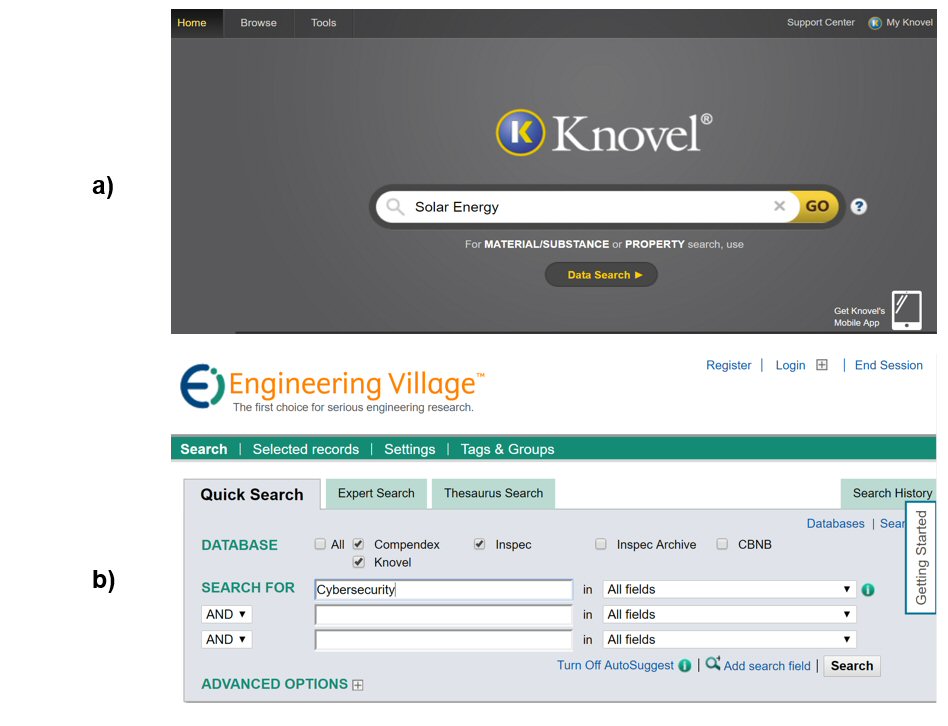
Figure 1: The a) Knovel and b) EngineeringVillage platforms
A team of six undergraduate and graduate students representing mechanical, electrical and biomedical engineering, materials, and computer science developed the entire challenge. This required them to become conversant in Knovel and EngineeringVillage, which was achieved primarily through peer-to-peer mentoring. Designing the game required all team members to become fluent in EngineeringVillage and Knovel searching and to develop a good understanding of the National Academy of Engineering Grand Challenges. The culmination of their efforts in the 2016 EAC is shown in Figure 2. Each question begins with a real-world scenario, which may include a short video, followed by four answer choices. Players may click to see a hint to help formulate search terms.
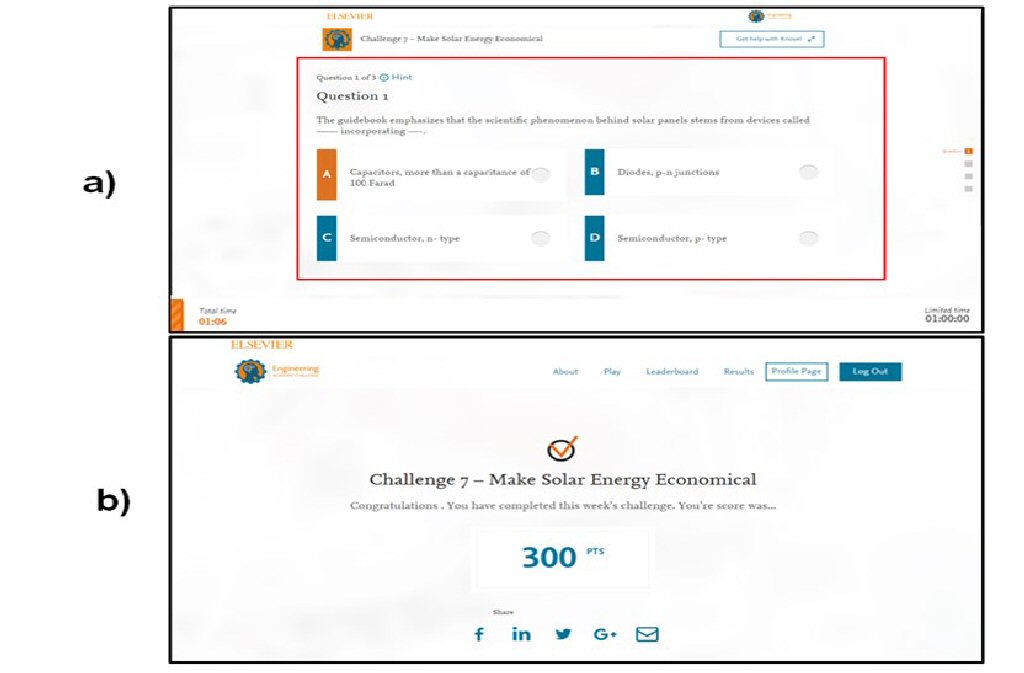
Figure 2: a) The 2016 EAC platform provides players hints, a timer, and direct link into the Knovel or EngineeringVillage platforms; b) Players can share wins with friends via social media
The game links directly to the NAE Grand Challenges, to provide students an opportunity to discover interests in engineering (Figure 3):
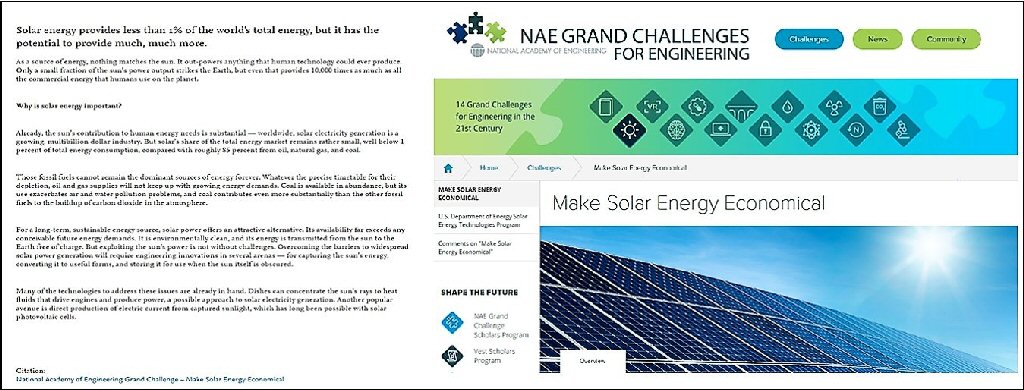
Figure 3: NAE Grand Challenges.
The Engineering Academic Challenge (and 2015 Knovel Academic Challenge) reached over 4,000 students in over 500 universities in approximately 60 countries worldwide. At the time of writing, approximately 80% of students (of 90 surveyed at Drexel) indicated that they were not familiar with NAE Grand Challenges prior to playing the game. Furthermore, 70% had not used either Knovel or EngineeringVillage prior to playing the game.
Campus Engagement
To drive on-campus interest in the global challenge, Drexel hosts a series of "Engineering Academic Challenge Marathon Nights," in which undergraduate and graduate students gather to play the challenge in a night enlivened with food, music, and various prizes. Non-engineering students attend these events as well, representing business, physics, biology, and chemistry. These environments facilitate peer-to-peer learning, networking, and collaboration. A dynamically-updating leaderboard (Figure 4) adds a fun competitive element to the game. Students playing as teams or individuals can watch their ranking rise or fall in real time during these marathons. As they play, students can unlock additional badges (Figure 4) for their performance in the game. In our opinion, badges known as microcredentials (MacArthur Foundation) that help individuals demonstrate specific skills or accomplishments may augment or even supplant traditional academic credentialing in the near future, creating an open marketplace of learning experiences.
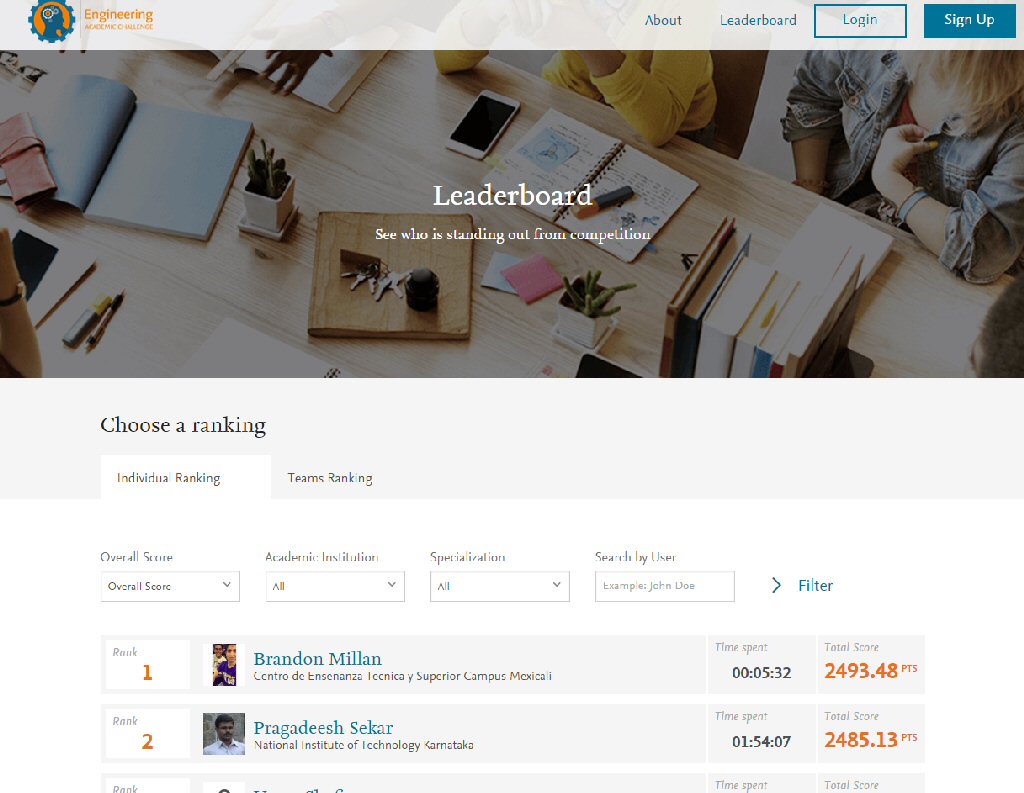
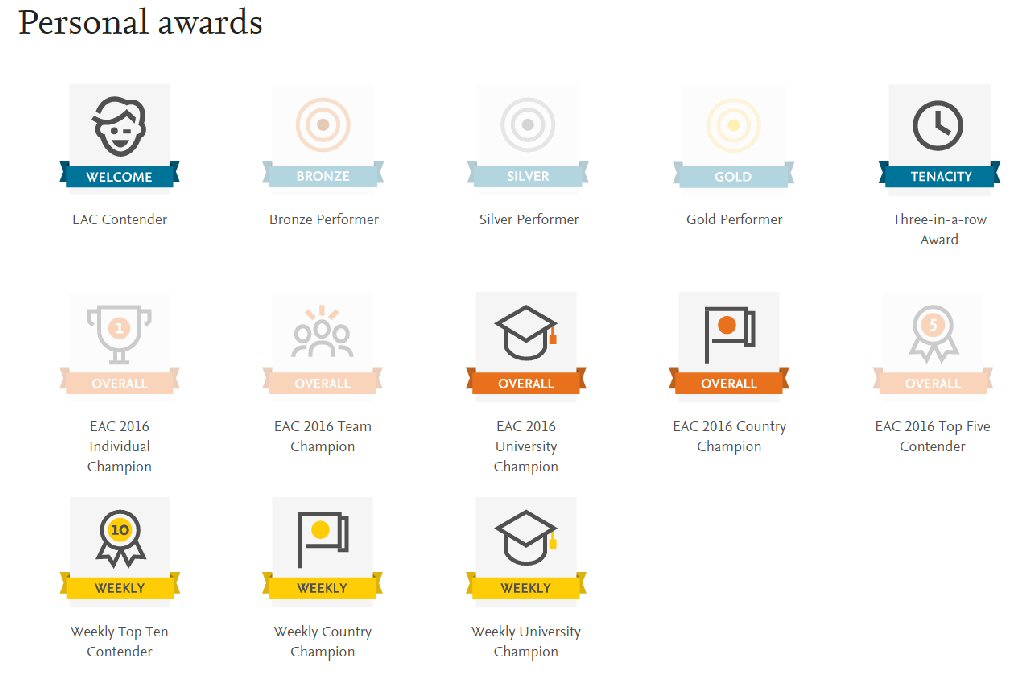
Figure 4: (top) A leaderboard updates in real-time throughout the game. (bottom) Students can also compete for social media badges

Figure 5: At Drexel, we create a series of "marathon nights" featuring free food, drinks, and prizes to create a fun informal learning environment for students to play the game.
Concluding Remarks
Students have a strong desire to become designers and makers of their worlds, which manifests itself in the strong "maker" movement. Students should be tapped as partners to transition STEM education away from "math/science death marches" to joyful, yet challenging experiences that empower students, such as those found in game-like environments. The classroom is just one of numerous spaces where learning can occur. Learning also occurs in makerspaces, research labs, libraries, dorms, at home, in the field, at the workplace, and online. The Engineering Academic Challenge is a cloud platform to augment faculty and librarians in information literacy education year-round, beyond the five weeks of the challenge. We plan to experiment with additional question types in near-future challenges with the option to mix and match question types.
Gameplay can perhaps lower barriers to internalizing the core skill set needed to independently seek multidisciplinary information. This in turn can enable students to synthesize this information into useful knowledge leading to the innovations of the future. We believe that digital, cloud-based platforms can enhance the engineering education experience, prompting re-examining of old assumptions and ideas, and conceiving new experiences.
Acknowledgements
We acknowledge Rishiraj Mathur, Aakankschit Nandkeolyar, Savannah Lee, and Krishna Dhanani for their hard work developing the Engineering Academic Challenge.
References
Annetta. L.A. 2010. The "I's" have it: A framework for serious educational game design. Review of General Psychology 14(2): 105-112. doi:10.1037/a0018985
Bebbington, S. & Vellino, A. 2015. Can playing Minecraft improve teenagers' information literacy? Journal of Information Literacy 9(12): 6-26. doi:10.11645/9.2.2029
Brockman, C. & Shirky, C. 2008. Gin, television, cognitive surplus. Edge. [Internet]. [Accessed 2016 Oct 30]. Available from: https://www.edge.org/conversation/clay_shirky-gin-television-and-cognitive-surplus
Cooper, S., Khatib, F., Treuille, A., Barbero, J., et al. 2010. Predicting protein structures with a multiplayer online game. Nature 466: 756-760. doi:10.1038/nature09304
De Rosa, C., Cantrell, J., Gallagher, P., Hawk, J. & Hoffman, I. 2014. At a Tipping Point: Education, Learning and Libraries: A Report to the OCLC Membership. Online College Library Center (OCLC). [Internet]. [Accessed 2016 Oct 30]. Available from: https://www.oclc.org/reports/tipping-point.en.html
De Rosa, C., Cantrell, J., Hawk, J. & Wilson, A. 2006. College Students' Perceptions of Libraries and Information Resources. Online College Library Center (OCLC). [Internet]. [Accessed 2016 Oct 30]. Available from: http://www.oclc.org/content/dam/oclc/reports/pdfs/studentperceptions.pdf
El-Nasr, M.S. & Smith, B.K. 2006. Learning through game modding. Computers in Entertainment (CIE) 4(1): 7. doi:10.1145/1111293.1111301
Fosmire, M. & Radcliffe, D. 2012. Knowledge-enabled Engineering Design: Toward an Integrated Model. Presented at: ASEE Annual Conference & Exposition, San Antonio, Texas. Available from: https://works.bepress.com/michael_fosmire/17/
Gee, J.P. 2003. What video games have to teach us about learning and literacy. Computers in Entertainment 1(1): 20. doi:10.1145/950566.950595
Grand Challenges for Engineering. 2014. National Academy of Engineering. [Internet]. [Accessed 2016 Oct 30]. Available from: http://www.engineeringchallenges.org
Jelaca, N. 2015. Usage of databases and the information literacy of students of the Faculty of Electrical Engineering and Computing. Paper presented at: Information and Communication Technology, Electronics and Microelectronics (MIPRO), 38th International Convention, Opatija, Croatia. doi:10.1109/MIPRO.2015.7160416
MacArthur Foundation. 2016. Digital Badges. [Cited December 14, 2916.] Available from: https://www.macfound.org/programs/digital-badges/
Markey, K., Leeder, C. & Hofer, A.R. 2011. BiblioBouts: What;s in the game? College & Research Libraries News 72(11): 632-645. Available from: http://crln.acrl.org/content/72/11/632.full
McGonigal, J. 2011. Reality is broken: why games make us better and how they can change the world. New York, Penguin Press.
Roberts, J.C. & Bhatt, J. 2007. Innovative approaches to information literacy instruction for engineering undergraduates at Drexel University. European Journal of Engineering Education 32(3): 243-251. doi:10.1080/03043790701276171
Salisbury, F. & Karasmanis, S. 2011. Are they ready? Exploring student information literacy skills in the transition from secondary to tertiary education. Australian Academic and Research Libraries 42(1): 43-58. doi:10.1080/00048623.2011.10722203
Science and Engineering Indicators 2014. 2014. National Science Board. [Internet]. [Accessed 2016 Oct 30]. Available from: https://www.nsf.gov/statistics/seind14/
Singer, G., Norbisrath, U. & Lewandowski, D. 2013. Ordinary search engine users carrying out complex search tasks. Journal of Information Science 39(3): 346-358. doi:10.1177/0165551512466974
Thompson, C. 2016. The Minecraft Generation. The New York Times. [Internet]. [Accessed 2016 Oct 30]. Available from: http://www.nytimes.com/2016/04/17/magazine/the-minecraft-generation.html?_r=0
Wang, X. 2013. Modeling entrance into STEM fields of study among students beginning at community colleges and four-year institutions. Research in Higher Education 54(6): 664-692. doi:10.1007/s11162-013-9291-x
| Previous | Contents | Next |

This work is licensed under a Creative Commons Attribution 4.0 International License.
